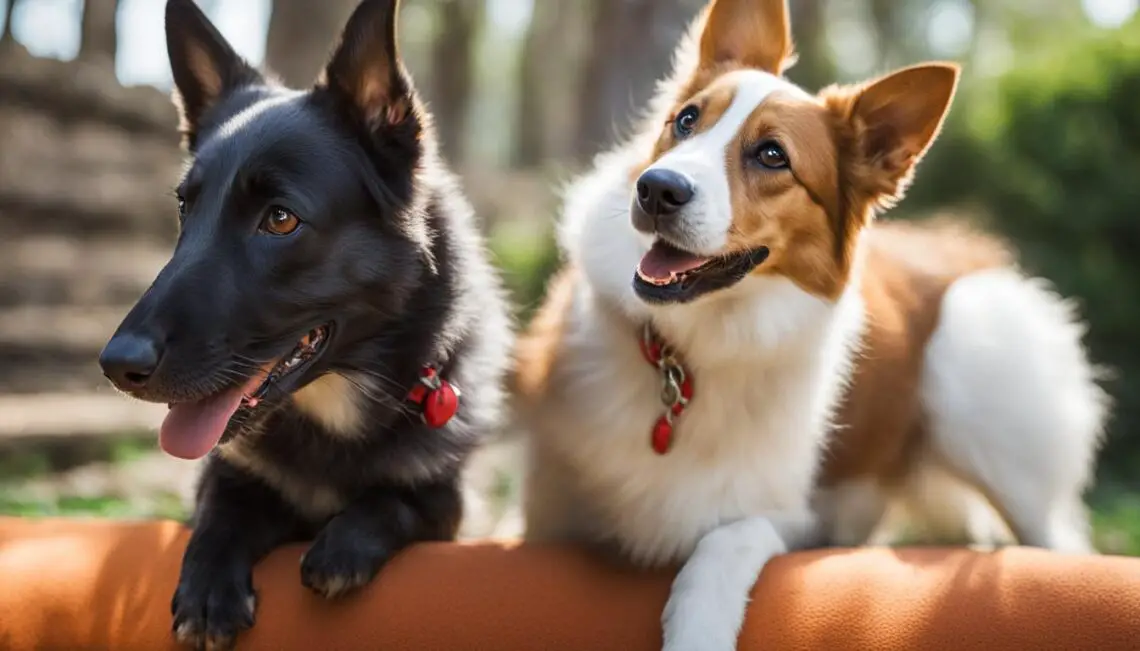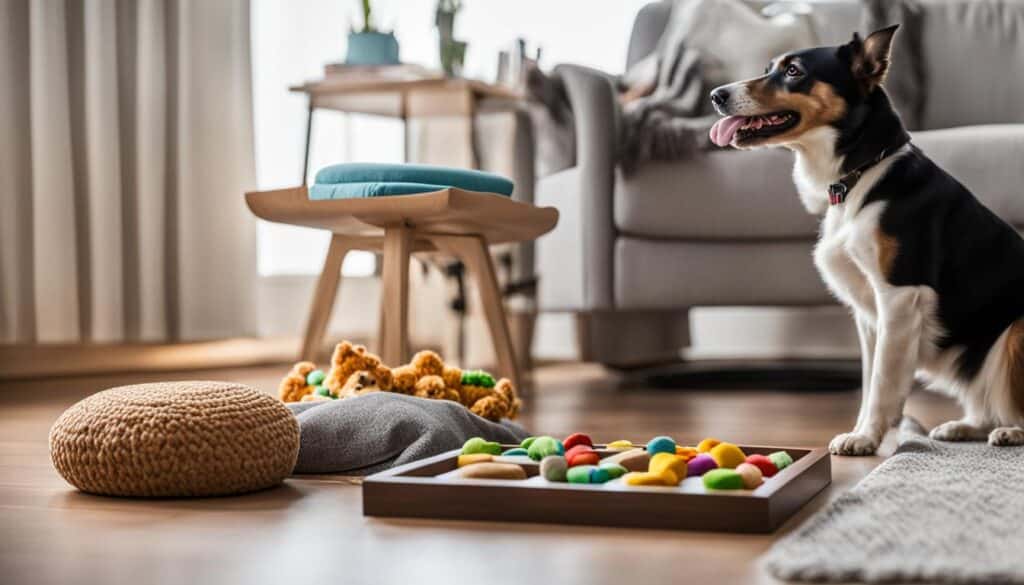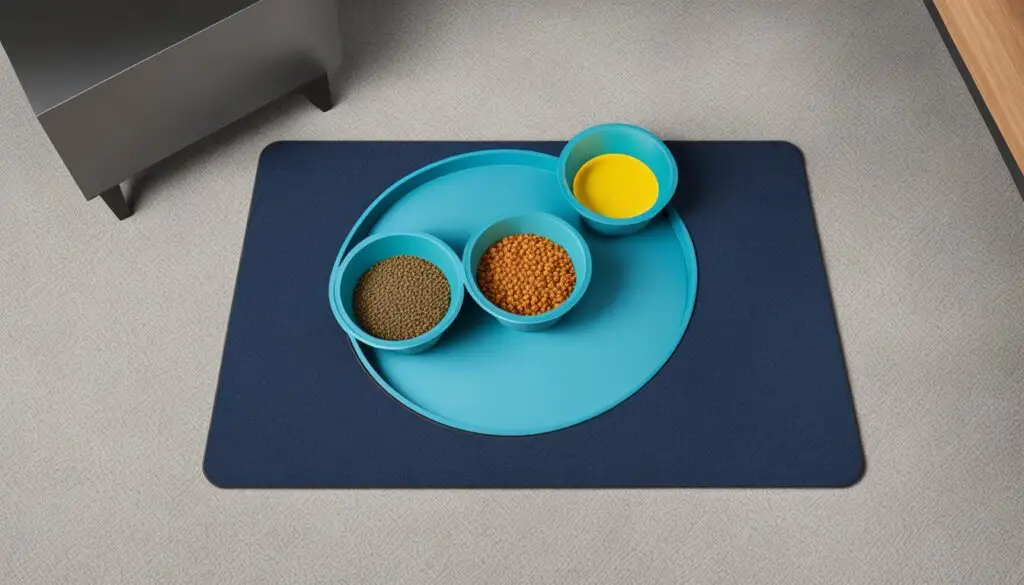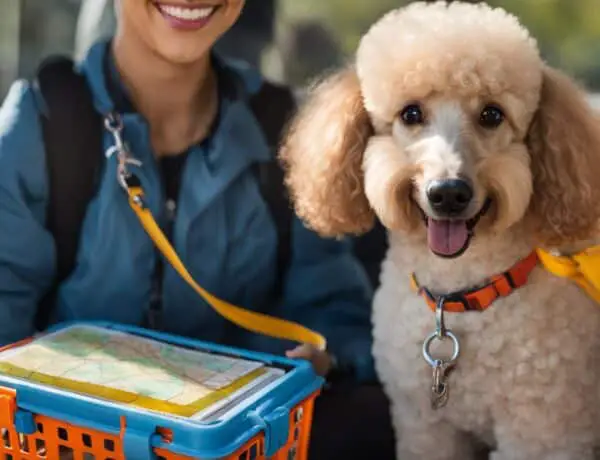Introducing a new pet to your household can be an exciting but challenging experience. As a pet owner, I understand the importance of a smooth transition when bringing a new furry friend home. To help you navigate this process successfully, I’m going to share some effective strategies that will make the introduction process easier for both you and your pets.
Key Takeaways:
- Creating a welcoming space for your new pet is crucial to their adjustment.
- Gradual introductions in neutral territory help prevent territorial disputes.
- Exchanging scents between pets familiarizes them with each other.
- Positive reinforcement builds a strong foundation for their relationship.
- Supervised interactions and separate feeding areas prevent conflicts.
Prepare Your Space: Creating a Welcoming Environment
Before bringing your new pet home, it’s crucial to prepare your space. Setting up a designated area with the appropriate amenities will create a welcoming environment for your furry friend.
Start by choosing a comfortable bedding that suits your pet’s needs. Whether it’s a cozy bed, a soft mat, or a warm crate, ensure that it’s clean and inviting. This will provide a familiar and safe haven for your new pet to retreat to as they adjust to their new surroundings.
Next, make sure to have a variety of toys available. Toys not only provide entertainment but also help alleviate stress and anxiety. Consider toys that are suitable for your pet’s age, breed, and size. Interactive toys, puzzle toys, and chew toys can engage their senses and keep them mentally stimulated.
In addition to bedding and toys, gather essential supplies such as food and water bowls, litter boxes, scratching posts, and grooming tools. Having these items readily available will help establish a routine and ensure your pet’s well-being.
“Creating a welcoming environment will help your new pet feel secure and ease their transition into their new home.”
Remember to place these items in a dedicated area of your home. This will not only provide structure but also give your new pet a clear understanding of their space.
Essential Supplies for a Welcoming Pet Environment
| Essential Supplies | Examples |
|---|---|
| Bedding | Cozy dog bed, soft cat mat, warm crate |
| Toys | Interactive toys, puzzle toys, chew toys |
| Food and Water Bowls | Stainless steel bowls, ceramic bowls |
| Litter Box | Standard litter box, covered litter box |
| Scratching Post | Vertical scratching post, horizontal scratching pad |
| Grooming Tools | Brushes, combs, nail clippers |
By preparing a suitable space with cozy bedding, engaging toys, and essential supplies, you’re creating a welcoming environment that will help your new pet feel secure and ease their transition into their new home.
Gradual Introductions: Taking it Slow
When introducing new pets to resident pets, it’s important to take it slow to ensure a harmonious transition. Rushing the process can lead to stress and potential conflicts. Instead, opt for gradual introductions that allow your pets to gradually get acquainted and establish a positive relationship.
One effective strategy is to conduct controlled introductions in neutral territory, such as a park. This helps prevent territorial disputes and allows both pets to feel more comfortable in a neutral environment. It’s best to have both animals on a leash during the initial meeting to maintain control and ensure safety.
Start by allowing your pets to sniff and observe each other from a distance. This gradual approach helps them become familiar with each other’s scents without feeling overwhelmed. Observe their body language and behavior during this interaction to ensure they are comfortable and relaxed.
Over time, gradually decrease the distance between the pets during each interaction. This can be done by allowing them to get closer to each other while maintaining control of their leashes. As they become more comfortable, you can eventually remove the leashes and monitor their interactions closely.
Key Points:
- Take it slow to prevent stress and conflicts
- Conduct controlled introductions in neutral territory
- Allow the pets to sniff and observe each other from a distance
- Gradually decrease the distance between the pets over time
- Monitor their interactions closely for any signs of discomfort or aggression
Remember, the goal is to create a positive and trusting relationship between your pets. Taking it slow allows them to establish their own dynamics at a comfortable pace, increasing the chances of a successful integration.
By following these gradual introduction strategies, you can help your new and resident pets build a strong foundation of trust and companionship. It’s important to be patient, observe their cues, and provide a safe and supportive environment throughout the process. With time and positive reinforcement, your pets can form a lasting bond that enriches your household.
Scent Exchange: Familiarizing Your Pets
Before the face-to-face meeting, it’s important to familiarize your new pet with the scent of your resident pets. This process, known as scent exchange, can help ease anxiety and facilitate a smoother introduction.
To perform scent exchange, you can try two effective methods:
- Swap Bedding: Take a piece of bedding or a blanket from your new pet’s living area and place it in the space of your resident pet. Similarly, take a piece of bedding or a blanket from your resident pet and place it in the space of your new pet. This will allow both pets to become accustomed to each other’s scent in a non-confrontational way.
- Use a Cloth: Take a clean cloth and gently rub it on your new pet, collecting their scent. Then, rub the same cloth on your resident pet, collecting their scent as well. Place the cloth with your resident pet’s scent in the space of your new pet, and vice versa. This helps to create a familiar scent in each pet’s environment before they meet face-to-face.
By engaging in scent exchange, you are facilitating a gradual introduction through the sense of smell, which is highly important for animals. This familiarization process can help reduce stress and increase the chances of a positive interaction when the pets finally meet.
Remember, when it comes to introducing a new pet, patience is key. Take the time to allow your pets to become familiar with each other’s scent before proceeding further.
Continue reading to learn about the importance of positive reinforcement when introducing a new pet.
Positive Reinforcement: Building a Strong Foundation
When introducing a new pet to your household, it’s crucial to establish a strong foundation between your pets. One effective way to achieve this is through the use of positive reinforcement. By rewarding good behavior and interactions, you can create a positive association between your pets and foster a harmonious relationship.
During the initial interactions, keep them short and positive to prevent overwhelming either pet. This allows them to gradually become more comfortable with each other without feeling anxious or stressed. Remember, patience and consistency are key when using positive reinforcement techniques.
Show appreciation for their good behavior by offering treats and verbal praise. For example, if both pets display calm and respectful behavior during their first meeting, reward them with their favorite treats or a special toy. This reinforces the notion that positive interactions result in enjoyable rewards.
It’s important to note that positive reinforcement should be used consistently throughout the introduction process. By doing so, you are building a solid foundation of trust and cooperation between your pets, setting the stage for a successful and harmonious relationship.
Introducing a new pet can be an exciting time, and by utilizing positive reinforcement, you can ensure a smooth transition and foster a strong bond between your pets. Remember to reward good behavior, keep interactions positive and brief, and be patient as your pets adjust to each other’s presence. Building a strong foundation with positive associations will lay the groundwork for a happy and harmonious household.
Supervised Interactions: Watching for Cues
When introducing a new pet to your household, it’s important to supervise their interactions and watch for cues from both pets. This ensures a safe and controlled environment for their first face-to-face meeting. Be patient and observant, paying close attention to their body language and behaviors.
If either pet shows signs of stress or aggression, it’s essential to separate them and try again later. This could include growling, lunging, raised hackles, or other aggressive displays. These cues indicate that the pets may not be ready for direct interaction and need more time to acclimate to each other.
“Watching for cues from your pets is crucial during the introduction process. Body language cues can provide important insights into their comfort levels and help you gauge the success of the transition.”
By supervising their interactions, you can intervene promptly if necessary and prevent any potential conflicts from escalating. Providing a calm and controlled environment will help both pets feel more secure and ease their transition into cohabitating.
Key Tips for Watching for Cues:
- Pay attention to their body language – ears, tail, posture, and eye contact
- Look for signs of relaxation, curiosity, and playful behavior
- Be aware of signs of stress, fear, or discomfort
- Separate the pets if aggression or signs of unease are displayed
Supervised interactions allow you to assess the progress of the introduction process and make informed decisions regarding the next steps. Remember, every pet is unique, and the time it takes for them to adjust to each other may vary. Patience and careful observation are essential to facilitating a successful and harmonious introduction.
Separate Feeding Areas: Preventing Conflicts
During the introductory phase of new pet introductions, it’s crucial to establish separate feeding areas to prevent potential conflicts. Feeding pets separately not only reduces the risk of food-related disputes but also fosters a positive feeding routine and minimizes competition.
By providing each pet with their own dedicated space during mealtime, you create a calm and controlled environment where they can focus on their food without feeling threatened or anxious. This practice promotes a sense of safety and security, allowing both pets to enjoy their meals peacefully.
Separate feeding areas also give you the opportunity to monitor each pet’s eating habits and ensure they receive their proper nutrition. It allows you to keep track of portion sizes, dietary restrictions, and any other specific needs for each pet.
“Feeding pets separately is an effective strategy to prevent conflicts and establish a harmonious mealtime routine. It’s an essential step in ensuring a smooth transition during the introduction of a new pet.”
When designating separate feeding areas, consider the following tips:
- Create a quiet and comfortable space for each pet’s mealtime. This can be a separate room, different corners of the same room, or using pet gates or barriers to create physical separation.
- Provide each pet with their own food and water bowls. Use labeled bowls or place them in separate areas to avoid confusion.
- Establish a consistent feeding schedule for each pet, ensuring they have their meals at the same time but in separate areas. This allows them to develop a routine and reduces the likelihood of competition or aggression.
- Monitor each pet’s eating habits to ensure they are eating well and adjust their diet if necessary.
Implementing separate feeding areas during the introductory phase of new pet introductions sets the foundation for a positive and harmonious relationship between your pets. It promotes a stress-free mealtime experience and prevents potential conflicts, allowing each pet to enjoy their food in a calm and safe environment.
Next, we’ll explore the importance of providing individual attention to each pet during the introduction process.
| Benefits of Separate Feeding Areas | Prevents feeding-related conflicts | Establishes a positive feeding routine | Minimizes competition between pets |
|---|---|---|---|
| Ensures each pet receives proper nutrition | Reduces stress and anxiety during mealtime | Allows for monitoring of portion sizes and dietary restrictions | Promotes a calm and safe feeding environment |
Give Each Pet Individual Attention
When introducing a new pet to your home, it’s important to give each pet individual attention. This not only helps prevent feelings of jealousy but also maintains the bond you share with your resident pet.
Your existing pet may feel anxious or neglected when a new pet arrives. By carving out dedicated time for each pet, you can ensure they feel loved and valued.
Here are some tips to give individual attention to each of your furry friends during the introduction process:
- Plan separate playtimes: Take the time to engage in one-on-one play sessions with each pet. This will help build a positive association between you and your new pet.
- Schedule individual cuddle time: Set aside specific moments in the day to cuddle and show affection to each pet. This reinforces their bond with you and helps them feel secure.
- Provide personalized training: Training sessions can be a great way to interact with your pets individually. Use positive reinforcement techniques and reward each pet for their individual progress.
Remember, introducing a new pet requires patience and understanding. By giving individual attention to each pet, you can help create a harmonious environment where everyone feels valued and loved.
Quote:
“Individual attention is the key to a successful introduction. By nurturing the bond with each pet, you can ensure a smooth transition for everyone involved.” – Dr. Emily Stevens, Veterinarian
Consult Your Veterinarian
When it comes to introducing a new pet into your household, seeking advice from a veterinarian is a crucial step for a successful transition. Your veterinarian can provide valuable insights and personalized recommendations based on their expertise and knowledge of your current pet’s temperament.
Your veterinarian can assess the health and behavior of your resident pet and offer guidance on how to introduce a new companion. They can help you determine the best approach based on factors such as the species, breed, age, and individual personalities of your pets.
Additionally, if your new pet has any medical conditions or special needs, your veterinarian can provide guidance on how to manage these in the context of the introduction process. They may also provide insights into potential challenges or risks to be aware of and help you develop a plan to address them.
By consulting your veterinarian, you can gain a professional perspective that considers the unique dynamics of your household. This advice will help you navigate the introduction process with confidence and ensure the well-being and harmony of all your furry family members.
Conclusion
Introducing a new pet to your household can be an exciting and rewarding experience. By following effective strategies, you can ensure a smooth transition for both your new and resident pets. It all starts with preparing your space to create a welcoming environment. Set up a designated area with bedding, toys, and essential supplies, providing a safe haven for your new pet as they adjust to their new surroundings.
Making gradual introductions is another crucial step. Take it slow and use controlled introductions in neutral territory to prevent territorial disputes. Leash your dog and allow them to sniff and observe each other from a distance, gradually decreasing the distance over time.
Exchange scents between your new and resident pets to help familiarize them with each other. Swap bedding or use a cloth to rub each pet’s scent, then place it with the other pet. This can help ease anxiety during the initial face-to-face meeting.
Using positive reinforcement and supervised interactions are essential for building a strong foundation and watching for cues. Reward good behavior and interactions with treats and praise, while being patient and observant of body language cues. Separate feeding areas and individual attention also contribute to a smooth transition, preventing conflicts and feelings of jealousy.
Finally, consulting your veterinarian before introducing a new pet is highly recommended. They can provide valuable insights into your current pet’s temperament and offer personalized advice based on their experience. Remember, patience and a thoughtful approach are key to creating a harmonious home for everyone involved.
FAQ
How can I create a welcoming environment for my new pet?
To create a welcoming environment, set up a designated area with bedding, toys, and essential supplies for your new pet.
What is the best way to introduce my new pet to my resident pets?
It’s important to take it slow when introducing new pets. Use controlled introductions in neutral territory and allow them to observe and sniff each other from a distance.
How can I familiarize my pets with each other’s scents?
By swapping bedding or using a cloth to rub each pet’s scent and placing it with the other pet, you can help them become familiar with each other’s scent.
What role does positive reinforcement play in introducing new pets?
Positive reinforcement is crucial for building a strong foundation between pets. Reward good behavior and interactions with treats and praise.
How should I supervise interactions between my new and resident pets?
It’s important to supervise interactions and watch for body language cues. If either pet shows signs of stress or aggression, separate them and try again later.
Why is it important to have separate feeding areas for new and resident pets?
Having separate feeding areas helps prevent potential food-related conflicts and establishes a positive feeding routine.
How can I ensure each pet receives individual attention during the transition?
Giving each pet individual attention helps prevent feelings of jealousy and maintain the bond with your resident pet.
Should I consult my veterinarian before introducing a new pet?
Yes, it’s always recommended to consult your veterinarian before introducing a new pet. They can provide insights into your current pet’s temperament and offer personalized advice.







No Comments